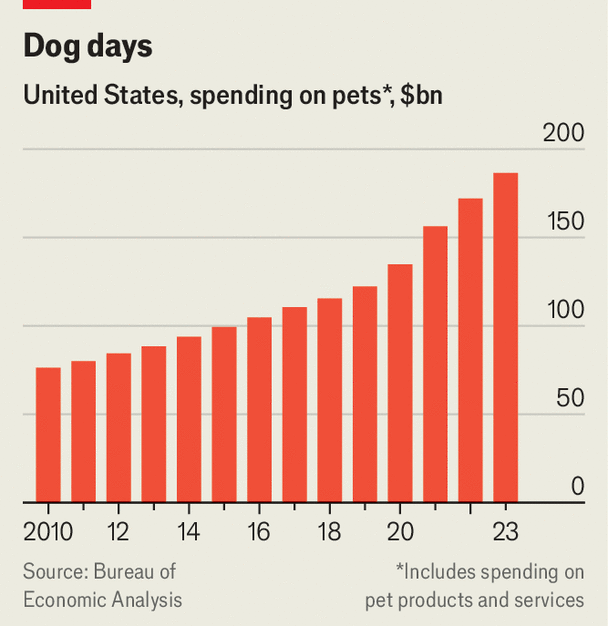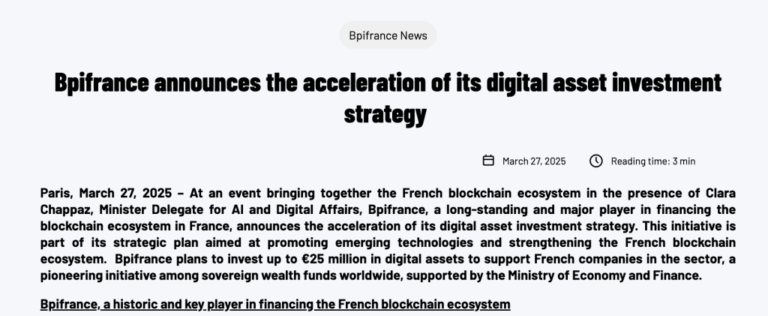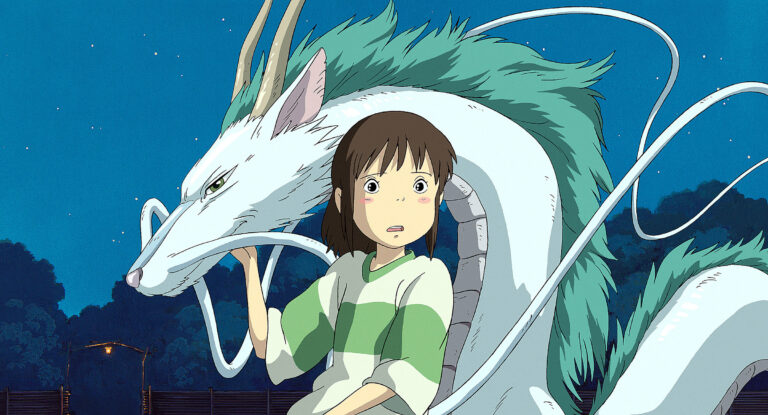Among the products of Dog by Dr Lisa, an Australian pet-care brand, you will find a cleanser for sensitive skin, a soothing balm and a cologne. All are free of genetically modified ingredients—and vegan, which dogs are not, at least by choice. Still, canines craving meat need not eat like animals: Butternut Box, a maker of fresh pet food taste-tested by humans, can offer your furry friend a low-fat chicken dish with peas, lentils and “a whiff of sage”. It is the most popular meal it offers.
There is little, it seems, that people won’t do for their pets. Americans spent $186bn on them last year, according to the Bureau of Economic Analysis, covering everything from food and vet visits to toys and grooming. That is more than they spent on childcare. Catering to pets has become big business. Mars, a company best known for its chocolate bars, made two-thirds of its revenue last year from pet-care. Besides owning the Royal Canin pet-food brand, the company also operates thousands of vet clinics. Nestlé and Colgate, two other consumer-products giants, also make around a fifth of their revenue from their pet divisions.

Spending on pets rocketed through the covid-19 pandemic, as lonely people adopted animals then splurged on them. Between 2019 and 2023 pet spending grew by a compound annual rate of 11%, in nominal terms, compared with 6% for consumer spending overall and 5% for pet spending over the preceding decade (see chart). Plenty more growth is yet to come.
Unlike virtual yoga classes or meal-kit subscriptions, animals weren’t easy to drop once lockdowns ended. Consumers, grappling lately with higher prices and a cooling job market, have been reluctant to inflict austerity on their pets. Morgan Stanley, a bank, reckons pet spending in America will grow by 2.5% this year, well ahead of estimates for, say, clothes. The pet business proved similarly resilient during the global financial crisis of 2007-09.
And analysts reckon the pet business will soon have the zoomies again. Morgan Stanley forecasts that annual spending will rise to around $260bn by 2030, consistent with its pre-pandemic growth trend. Behind that is a shift in the relationship between pets and humans. Owners increasingly see themselves as parents, not masters. “Pets have gone from the backyard to the living room to the bedroom,” says Loïc Moutault, head of the pet division at Mars.
That change is playing out across generations. Millennials, many of whom have put off having children, have more fur babies per household than any other generation in America. Gen Z is proving to be equally pet-loving. “Millennials and Gen Z see their pets differently,” says Kristin Peck, chief executive of Zoetis, a drugmaker for animals. “They really see them as part of their families.”
Dogs, cats and other animals lucky enough to be welcomed into such families are in for a treat. Younger owners might take their pets to the vet more often, to the animals’ dismay, but they make up for it by giving them more presents. Some 95% of Gen Z owners surveyed last year by the American Pet Products Association, an industry group, said they bought their dog a gift at least once a year, compared with 81% of boomers. The average cost of those gifts was a lavish $44 among Gen Z owners, compared with $17 among boomers.
Owners are also now giving their pets yummier food. At Freshpet, an American pet-food producer founded in 2006, sales are more than double what they were three years ago. It only uses natural ingredients. William Cyr, its boss, says the firm is gaining from the “humanisation” of pets. “Canned dog food was invented in 1922,” Mr Cyr says. “And it smells like it.”
All this is attracting plenty of newcomers to the pet industry. Private-equity firms have poured so much money into buying and consolidating vet clinics that they have caught the attention of antitrust regulators in America and Britain. Earlier this month Gilles Andrier, the boss of Givaudan, a Swiss company that is the world’s largest manufacturer of flavours and fragrances, said his firm is eyeing the pet-food market. “People spend more money on pets than kids nowadays,” he explained. Best, then, to have a dog in the fight. ■
To stay on top of the biggest stories in business and technology, sign up to the Bottom Line, our weekly subscriber-only newsletter.


















